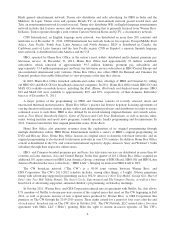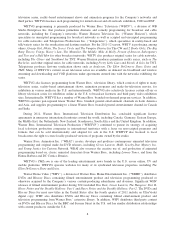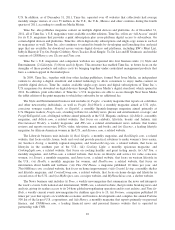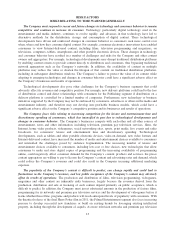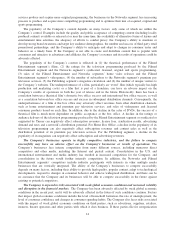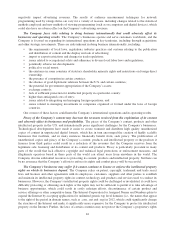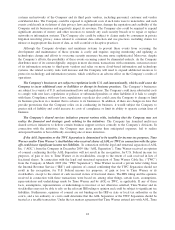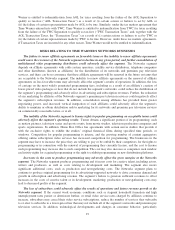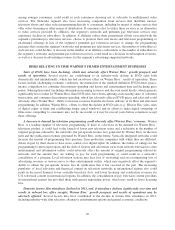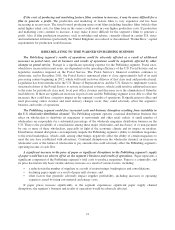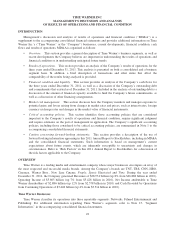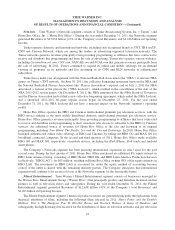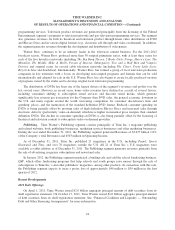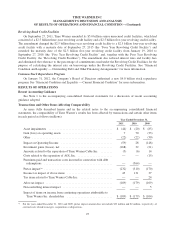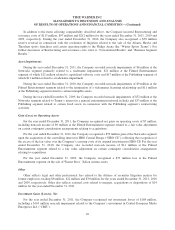Time Magazine 2011 Annual Report Download - page 30
Download and view the complete annual report
Please find page 30 of the 2011 Time Magazine annual report below. You can navigate through the pages in the report by either clicking on the pages listed below, or by using the keyword search tool below to find specific information within the annual report.negatively impact advertising revenues. The results of audience measurement techniques for network
programming used by ratings firms can vary for a variety of reasons, including changes related to the statistical
methods employed and new methods of viewing programming (such as on computers and digital devices), which
could also have an adverse effect on the Company’s advertising revenues.
The Company faces risks relating to doing business internationally that could adversely affect its
businesses and operating results. The Company’s businesses operate and serve customers worldwide, and the
Company is focused on expanding its international operations in key territories, including through acquisitions
and other strategic investments. There are risks inherent in doing business internationally, including:
• the requirements of local laws, regulations, industry practices and customs relating to the publication
and distribution of content and the display and sale of advertising;
• import or export restrictions and changes in trade regulations;
• issues related to occupational safety and adherence to diverse local labor laws and regulations;
• potentially adverse tax developments;
• political or social unrest;
• the existence in some countries of statutory shareholder minority rights and restrictions on foreign direct
ownership;
• the presence of corruption in certain countries;
• the absence of good diplomatic relations between the U.S. and certain countries;
• the potential for government appropriation of the Company’s assets;
• exchange controls;
• lack of sufficient protection for intellectual property in a particular country;
• higher than anticipated costs of entry;
• issues related to integrating and managing foreign operations; and
• issues related to managing investments in companies organized or formed under the laws of foreign
countries.
One or more of these factors could harm the Company’s international operations and its operating results.
Piracy of the Company’s content may decrease the revenues received from the exploitation of its content
and adversely affect its businesses and profitability. The piracy of the Company’s content, products and other
intellectual property in the U.S. and internationally poses significant challenges for the Company’s businesses.
Technological developments have made it easier to create, transmit and distribute high quality unauthorized
copies of content in unprotected digital formats, which has in turn encouraged the creation of highly scalable
businesses that facilitate, and in many instances financially benefit from, such piracy. The proliferation of
unauthorized copies and piracy of the Company’s content, products and intellectual property or the products it
licenses from third parties could result in a reduction of the revenues that the Company receives from the
legitimate sale, licensing and distribution of its content and products. Piracy is particularly prevalent in many
parts of the world that lack effective copyright and technical legal protections or enforcement measures, and
illegitimate operators based in these parts of the world can attract users from anywhere in the world. The
Company devotes substantial resources to protecting its content, products and intellectual property, but there can
be no assurance that the Company’s efforts to enforce its rights and combat piracy will be successful.
The Company’s businesses may suffer if it cannot continue to license or enforce the intellectual property
rights on which its businesses depend. The Company relies on patent, copyright, trademark and trade secret
laws and licenses and other agreements with its employees, customers, suppliers and other parties to establish
and maintain its intellectual property rights in content, technology and products and services used to conduct its
businesses. However, the Company’s intellectual property rights could be challenged or invalidated, it could have
difficulty protecting or obtaining such rights or the rights may not be sufficient to permit it to take advantage of
business opportunities, which could result in costly redesign efforts, discontinuance of certain product and
service offerings or other competitive harm. The Internet Corporation for Assigned Names and Numbers plans to
expand the Internet by accepting applications for unlimited generic top level domains (i.e., the names that appear
to the right of the period in domain names, such as .com, .net and .org) in 2012, which could significantly change
the structure of the Internet and make it significantly more expensive for the Company to protect its intellectual
property on the Internet. Further, the laws of certain countries may not protect the Company’s proprietary rights
16


